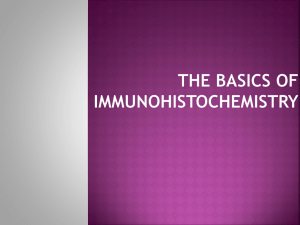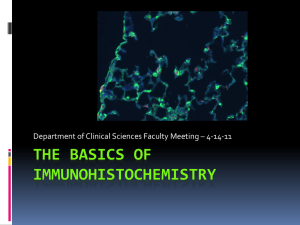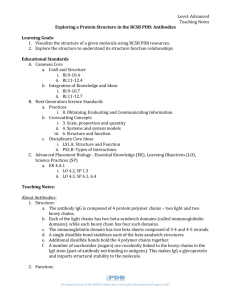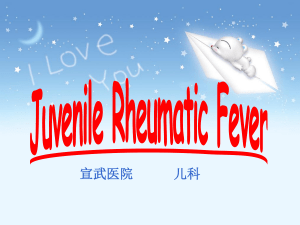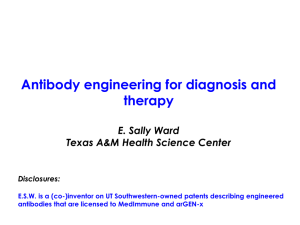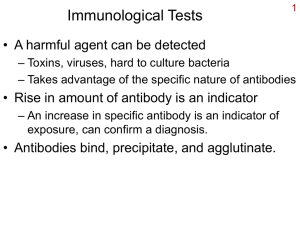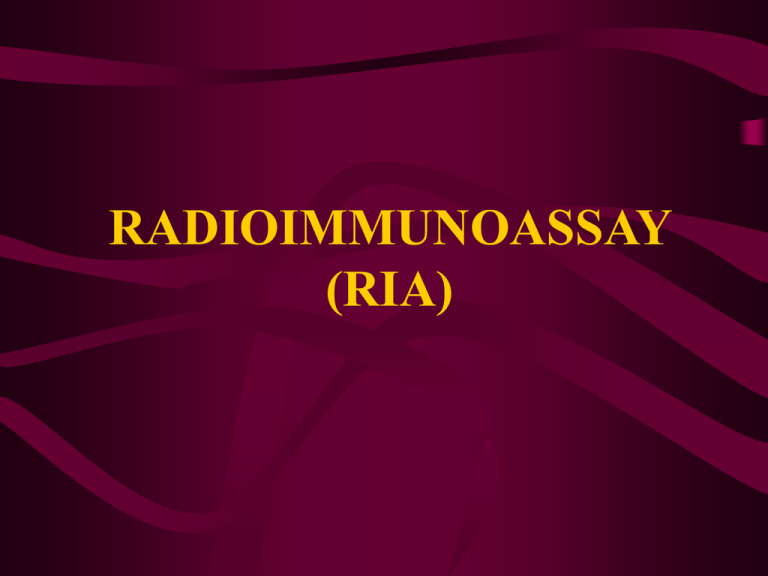
RADIOIMMUNOASSAY
(RIA)
INTRODUCTION
RIA is a nuclear technique widely used for
measuring minute substances with IN VITRO
Procedures.
It combined the technology of nuclear
medicine (tracer technique) and immunology
(antigen-antibody binding) so that the name
RIA is designated. Someone called it was a
hybrid technique.
This technique has been developed in 1959 by
Solomen Berson and Rosalyn Yalow in
Bronx,New York. For her contribution of this
important analytical technique ot medical science,
R. Yolow shared the 1977 Nobel price in Medicine
and physiology.
In earlier days RIA only limited to certain
hormone, but now the scope greatly expanded
to the field of reproductive physiology,
oncology, immunology, hematology,
pharmacology and parasitology etc. It makes a
great contribution to the diagnostic laboratory
and scientific research works.
PRINCIPLE
• Ag, Ab, and *Ag
Ag --- Antigen to be assayed in serum.
(unknown or standard)
Variant
*Ag --- Labeled antigen added in minute
amount of radioactivity equally in each tube
Nonvariant (constant)
Ab --- Antibody added in minute amount of
dilution equally in each tube
Nonvariant (constant) and limited
• Competing depression reaction
Labeled antigen (*Ag) possesses the same
properties of unlabeled antigen (Ag). It can also
bind to the correlated specific antibody (Ab)
with the formation of labeled antigen-antibody
complex or called bound antigen (B), leave the
unbound one as free labeled antigen (F).
The more Ag is present, the less likely is the *Ag
bound to the Ab, thus the amount of B formed is
inversely proportional to the Ag originally
present in serum, this is so called competing
depression reaction.
Ag+Ab
+
*Ag
Ag.Ab+Ag
* Ag.Ab (B)+*Ag (F)
B%
concentration
BASIC TECHNIQUE
• Standard substance
The fundamentals of accurate
quantitation: they must be as same as
the antigen which will be assayed.
• Labeled antigen
1. Minute amount: less than the
minimum of the Ag to be assayed
2. Optimal specific activity
3. Radiochemical purity: >95%
4. Good immunoactivity
5. Stability
• Specific binding substance
Antibody in high binding affinity
The higher affinity, the more sensitive
There are some specific binding globulin
besides antibody.
Cortical binding globulin for cortisol
Thyroid binding globulin for TH
Sex binding globulin for P, E
• Separating reagent (SR)
Separation of B and F
1. Non specific SR: (absorbing F)
DCC(葡聚糖包裹的活性碳), PEG(聚乙
二醇)
2. Specific SR: (absorbing B)
second antibody
3. Solid phase SR: (absorbing Ab on solid
material)
IRMA
• Ag, and *Ab
Ag --- Antigen to be assayed in serum.
( unknown or standard)
Variant
*Ab --- Labeled antibody added in minute
amount of radioactivity equally in each tube
Constant and overdose
Ag+*Ab
Ag.*Ab+*Ab
(B)
(F)
• Ag can bind to specific *Ab to form Ag*Ab
complex (B), and leave free *Ab (F).
• The amount of B formed is proportional to
the Ag originally present in serum.
• Separate B and F.
结
合
率
IRMA
Ag剂量
COMPARE IRMA WITH RIA
RIA
IRMA
Labeled substance
Ag
Ab
Principle
Competing depression Noncompetitive
Ab
Limited
Overdose
Standard curve
Negative
Positive
Balance
Slow
Fast
Measure range
Narrow
Wide
Measure object Large or small molecular Large molecular
QUALITY INDEX
• High Sensitivity
• Strong Specificity
• Precise in Precision
• Good Accuracy
DEVELOPMENT
Tracer
Condition
Procedure
Automation
Separation
Stability
Validity
Factors
Incubation
RIA
CLIA
125I
吖啶酯
liquid, solid
solid
easy
easy
no
yes
centrifugation, wash wash
high
high
short
long
many
few
long
short
ECLI TRFIA
Ru2+ Eu3+
solid solid
easy easy
yes
yes
wash wash
high high
long long
few many
short long
TUMOR MARKER
Clinic application:
• Assistant diagnosis.
• Observe treatment response.
• Monitor metastasis, recrudesce, and
prognosis.
• Screen in high incidence area.
Tumor site
Tumor marker
Adenocarcinoma
CEA
Primary hepatoma
AFP
Pancreatic and bile cancer
CA19-9, CA242
Gastrointestinal cancer
CEA, CA19-9, CA72-4
Lung cancer
CEA, CYFRA21-1, NSE, CA125
Breast cancer
CA153, CEA
Ovary cancer
CA125
Cervix cancer
SCC
Prostate cancer
PSA, FPSA
Other
CA50, Fe, β2-M


